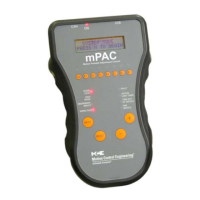Load Testing AC Drives
3-23
3
Motion 4000
2. Measure the voltage across the controller braking resistors. If there is no measured volt-
age (car slowing/full load/descending or car slowing/no load/ascending), there may be
a wiring problem or a defective brake module.
3. Investigate and solve this problem. The regenerative resistors or the brake module regu-
late car speed during full load down or empty load up conditions and are critical to
safety. Contact MCE if necessary.
Electrical Noise
If the motor makes excessive electrical noise or draws higher than normal current:
• Check Encoder Polarity (KEB, TorqMAX) on page 2-47 or Align Encoder (Magnetek) on
page 2-47.
• Check KEB LF.29. Try changing it from 4 to 8 or from 8 to 16.
• Verify traction sheave diameter and correct entry in drive parameter.
• Verify machine gear reduction ratio and correct entry in drive parameter.
• Verify Rated Motor Speed and correct entry in drive parameter.
• Verify acceleration and deceleration integral and proportional gain drive settings. Refer to
drive manufacturer manual for detail.
Imperial motor nameplates list full load RPM. With induction motors, this value is equal to syn-
chronous RPM less slip. If your motor lists only synchronous RPM, you must determine its slip
percentage and subtract that amount to arrive at rated motor speed.
For example, a Reuland motor in a flux vector application has slip between 1.8% and 2.0%. If
synchronous RPM is 1200, 1.8% of that is about 22 RPM so rated motor speed would be 1200
minus 22 = 1178 RPM. (F5 drive parameter LF.11. If you auto-tuned the drive to the motor, this
parameter is learned and should not become a problem.)

